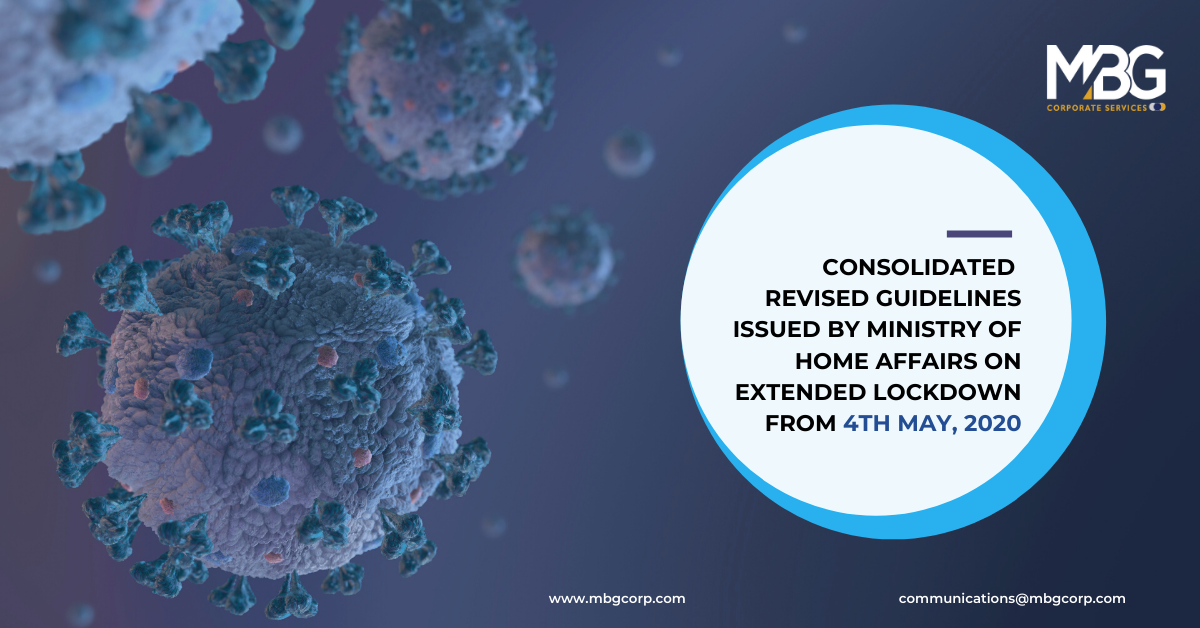Consolidated Revised Guidelines Issued by Ministry of Home Affairs on Extended Lockdown from 04th May, 2020

Ministry of Home Affairs (MHA) has on the 01st day of May 2020 issued an order under Disaster Management Act, 2005, and extended the lockdown for a further period of two weeks beyond May 4, 2020. MHA also issued new guidelines to regulate different activities in this period, the entire country has been color-coded into Red, Orange, and Green Zones. The rules are the strictest in the Red Zone districts and get progressively easier in the Orange and Green Zones.
Identification of Zones
The criteria for identification of districts as Red, Green, and Orange Zones have been spelled out in detail as below:
Green Zones- Green shall be defined as per the following criteria: districts with zero confirmed case till date; or; districts with no confirmed case is the last 21 days.
Red Zones- Districts shall be defined as Red Zones, by the Ministry of Health and Family Welfare (MoHFW), Government of India (GoI), taking into account the total number of active cases, doubling the rate of confirmed cases, the extent of testing and surveillance feedback.
Orange Zones- Those districts, which are neither defined as Red nor Green, shall be classified as Orange zones.
The classification of districts into Red, Green, and Orange Zones will be shared by the Ministry of Health and Family Welfare (MoHFW) with the States and Union Territories (UTs) on a weekly basis, or earlier, as required.
Containment Zones
The most sensitive areas of the Country, from the spread of COVID-19 point of view and falling within the Red and Orange Zones, are designated as Containment Zones. The local authority shall ensure 100% coverage of the Aarogya Setu app among the residents of the Containment Zone. Containment Zones would have intensified surveillance protocols, with contact tracing, house to house surveillance, home/ institutional quarantining of persons based on their risk assessment, and clinical management. Strict perimeter control would need to be ensured, so that there is no movement of people in and out of these Zones, except for medical emergencies, and for maintaining supply of essential goods and services. No other activity is permitted within the Containment Zones.
Summary of Activities Allowed, Prohibited and Restricted in Containment Zones, Green Zones, Orange Zones, and Red Zones.







 National Directives for COVID-19 Management
The National Directives shall be enforced by the District Magistrate through fines and penal action as prescribed in the Disaster Management Act 2005.
Public Places
National Directives for COVID-19 Management
The National Directives shall be enforced by the District Magistrate through fines and penal action as prescribed in the Disaster Management Act 2005.
Public Places







 National Directives for COVID-19 Management
The National Directives shall be enforced by the District Magistrate through fines and penal action as prescribed in the Disaster Management Act 2005.
Public Places
National Directives for COVID-19 Management
The National Directives shall be enforced by the District Magistrate through fines and penal action as prescribed in the Disaster Management Act 2005.
Public Places
- Wearing face cover is compulsory in all public places.
- All persons in charge of public places and transport shall ensure social distancing as per the guidelines issued by the Ministry of Health and Family Welfare.
- No organization /manager of a public place shall allow gathering of 5 or more persons
- Marriage related gathering shall ensure social distancing, and the maximum number of guests allowed shall not be more than 50.
- Funeral/ last rites related gathering shall ensure social distancing, and the maximum number allowed shall not be more than 20.
- Spitting in public spaces shall be punishable with a fine.
- There should be a strict ban on the consumption of liquor, gutka, tobacco etc.
- Shops selling liquor, paan, gutka, tobacco etc. will ensure a minimum 6 feet distance from each other, and also ensure that not more than 5 peoples are present at one time at the shop.
- Wearing of face cover is compulsory in all workplaces and adequate stock of such face cover shall be made available.
- All persons in charge of workplaces shall ensure social distancing as per the guidelines issued by the Ministry of Health and Family Welfare, both within the workplaces and in-company transport.
- Social distancing at workplaces shall be ensured through adequate gaps between shifts, staggering the lunch breaks of staff,
- Provision for thermal scanning, hand wash and sanitizer preferably with touch-free mechanism will be made at all entry and exit points and common areas. In addition, sufficient quantities of hand wash and sanitizer shall be made available in the workplace.
- Frequent sanitization of the entire workplace, common facilities, and all points which come into human contact e.g. door handles, etc., shall be ensured, including between shifts.
- Persons above 65 years of age, persons with co-morbidities, pregnant women, and children below the age of 10 years shall stay at home, except for meeting essential requirements and for health purposes.
- Use of Arogya Setu app shall be made mandatory for all employees, both private and It shall be the responsibility of the Head of the respective Organizations to ensure 100% coverage of this app among the employees.
- Large physical meetings to be avoided
- Hospitals/ clinics in the nearby areas, which are authorized to treat COVID-19 patients, should be identified and list should be available at the workplace all the time. Employees showing any symptoms of COVID-19 should be immediately sent for a check-up to such facilities. Quarantine areas should be earmarked for isolating employees showing symptoms until they are safely moved to the medical facilities.
- Arrangements for transport facilities shall be ensured with social distancing, wherever personal/ public transport is not feasible.
- Intensive communication and training on good hygiene practices shall be taken up.
Tag: Covid 19, Lockdown


